The Influence of Lime Material and Nitrogen Fertilization on Reed Canary Grass Productivity, Plant Quality and Environmental Impact of Using Biomass for Energy Purposes
Abstract
1. Introduction
2. Methods
2.1. The Field Experiment Site and Design
2.2. Assessment of Biofuel Production, Energy Use and Harmful Emissions
2.2.1. Biofuel Production and Qualitative Parameters of the Pellets
2.2.2. Determination of Harmful Emissions
2.3. Statistical Analysis of Experimental Data
3. Results and Discussion
3.1. Meteorological Conditions
3.2. Dry Matter (DM) Yield, LUE and NUE
R = 0.88; R2 = 0.77, or (%) − 77.0431; F act. = 4.03
R = 0.96; R2 = 0.92 or (%) − 91.76; F act. = 13.36 **
3.3. Correlation between Biomass Yield and Nitrogen Nutrition Index
3.4. Recycling of Plants to Biofuel and Utilization for Energy Purposes
4. Conclusions
Author Contributions
Funding
Institutional Review Board Statement
Informed Consent Statement
Data Availability Statement
Acknowledgments
Conflicts of Interest
References
- Lewandowski, I.; Scurlock, J.M.O.; Lindwall, E.; Christou, M. The development and current status of perennial rhizomatous grasses as energy crops in the US and Europe. Biomass Bioenergy 2003, 25, 335–361. [Google Scholar] [CrossRef]
- Marks-Bielska, R.; Bielski, S.; Novikova, A.; Romaneckas, K. Straw Stocks as a Source of Renewable Energy. A Case Study of a District in Poland. Sustainability 2019, 11, 4714. [Google Scholar] [CrossRef]
- Ymeri, P.; Gyuricza, C.; Fogarassy, C. Farmers’ Attitudes towards the Use of Biomass as Renewable Energy—A Case Study from Southeastern Europe. Sustainability 2020, 12, 4009. [Google Scholar] [CrossRef]
- Shurpali, N.J.; Hyvönen, N.P.; Huttunen, J.T.; Clement, R.J.; Reichstein, M.; Nykänen, H.; Biasi, C.; Martikainen, P.J. Cultivation of a perennial grass for bioenergy on a boreal organic soil—Carbon sinks or source? Glob. Change Biol. Bioenergy 2009, 1, 35–50. [Google Scholar] [CrossRef]
- Mažvila, J.; Adomaitis, T.; Eitmanavičius, L. Changes in the acidity of Lithuania’s soils as affected of not liming. Zemdirbyste 2004, 88, 3–20. (In Lithuanian) [Google Scholar]
- Blanco-Canqui, H. Growing Dedicated Energy Crops on Marginal Lands and Ecosystem Services. Soil Sci. Soc. Am. J. 2016, 4, 845–858. [Google Scholar] [CrossRef]
- Fernando, A.L.; Duarte, M.P.; Almeida, J.; Boléo, S.; Mendes, B. Environmental impact assessment of energy crops cultivation in Europe. Biofuel. Bioprod. Biorefin. 2010, 4, 594–604. [Google Scholar] [CrossRef]
- Rahimi, V.; Shafiei, M. Techno-economic assessment of a biorefinery based on low-impact energy crops: A step towards commercial production of biodiesel, biogas, and heat. Energy Convers. Manag. 2019, 183, 698–707. [Google Scholar] [CrossRef]
- Sherringtona, C.; Bartleyb, J.; Morana, D. Farm-level constraints on the domestic supply of perennial energy crops in the UK. Energy Policy 2008, 36, 2504–2512. [Google Scholar] [CrossRef]
- Carlsson, G.; Martensson, L.-M.; Prade, T.; Svensson, S.-E.; Jensen, E.S. Perennial species mixtures for multifunctional production of biomass on marginal land. Glob. Change Biol. Bioenergy 2017, 9, 191–201. [Google Scholar] [CrossRef]
- Scordia, D.; Cosentino, S.L. Perennial Energy Grasses: Resilient Crops in a Changing European Agriculture. Agriculture 2019, 9, 169. [Google Scholar] [CrossRef]
- Tilvikienė, V.; Venslauskas, K.; Navickas, K.; Župerka, V.; Dabkevičius, Z.; Kadžiulienė, Ž. The biomass and biogas productivity of perennial grasses. Zemdirbyste 2012, 99, 17–22. [Google Scholar]
- Christian, D.G.; Yates, N.E.; Riche, A.B. The effect of harvest date on the yield and mineral content of Phalaris arundinacea L. (reed canary grass) genotypes screened for their potential as energy crops in southern England. J. Sci. Food Agric. 2006, 86, 1181–1188. [Google Scholar] [CrossRef]
- Hadders, G.; Olsson, R. Harvest of grass for combustion in late summer and in spring. Biomass Bioenergy 1997, 12, 171–175. [Google Scholar] [CrossRef]
- Lord, R.A. Reed canarygrass (Phalaris arundinacea) outperforms Miscanthus or willow on marginal soils, brownfield and non-agricultural sites for local, sustainable energy crop production. Biomass Bioenergy 2015, 78, 110–125. [Google Scholar] [CrossRef]
- Ustak, S.; Šinko, J.; Muňoz, J. Reed canary grass (Phalaris arundinacea L.) as a promising energy crop. J. Cent. Eur. Agric. 2019, 20, 1143–1168. [Google Scholar] [CrossRef]
- Wrobel, C.; Coulman, B.E.; Smith, D.L. The potential use of reed canarygrass (Phalaris arundinacea L.) as a biofuel crop. Acta Agric. Scand. B Soil Plant Sci. 2009, 59, 1–18. [Google Scholar]
- Kukk, L.; Roostalu, H.; Suuster, E.; Rossner, H.; Shanskiy, M.; Astover, A. Reed canary grass biomass yield and energy use efficiency in Northern European pedoclimatic conditions. Biomass Bioenergy 2011, 35, 4407–4416. [Google Scholar] [CrossRef]
- Levesque, M.P.; Mathur, S.P. Effect of liming on yield and nutrient concentration of reed canarygrass grown in two peat soils. Can. J. Soil Sci. 1983, 63, 469–478. [Google Scholar] [CrossRef]
- Ridley, A.M.; Windsor, S.M. Persistence and tolerance to soil acidity of phalaris and cocksfoot in north-eastern Victoria. Aust. J. Exp. Agric. 1992, 32, 1069–1075. [Google Scholar] [CrossRef]
- Hayes, R.C.; Li, G.D.; Conyers, M.K.; Virgona, J.M.; Dear, B.S. Lime increases productivity and the capacity of lucerne (Medicago sativa L.) and phalaris (Phalaris aquatica L.) to utilise stored soil water on an acidic soil in south-eastern Australia. Plant Soil 2016, 400, 29–43. [Google Scholar] [CrossRef]
- Pocienė, L.; Kadžiulienė, Ž. Biomass yield and fibre components in reed canary grass and tall fescue grown as feedstock for combustion. Zemdirbyste 2016, 103, 297–304. [Google Scholar] [CrossRef]
- Shield, I.F.; Barraclough, T.J.P.; Riche, A.B.; Yates, N.E. The yield response of the energy crops switchgrass and reed canary grass to fertiliser applications when grown on a low productivity sandy soil. Biomass Bioenergy 2012, 42, 86–96. [Google Scholar] [CrossRef]
- Strašil, Z.; Váňa, V.; Káš, M. The reed canary grass (Phalaris arundinacea L.) cultivated for energy utilization. Res. Agric. Eng. 2005, 51, 7–12. [Google Scholar] [CrossRef]
- Bailey, J.S. Liming and nitrogen efficiency: Some effects of increased calcium supply and increased soil pH on nitrogen recovery by perennial ryegrass. Commun. Soil Sci. Plant Anal. 1995, 26, 1233–1246. [Google Scholar] [CrossRef]
- Bednarek, W.; Reszka, R. Effect of liming and fertilization with various nitrogen forms on the content of some cations in spring barley. Acta Agrophys. 2008, 12, 29–38. [Google Scholar]
- Iglinski, B.; Iglin, A.; Kujawski, W.; Buczkowski, M.; Cichosz, R. Bioenergy in Poland. Renew. Sustain. Energy Rev. 2011, 15, 2999–3007. [Google Scholar] [CrossRef]
- Kadžiulienė, Ž.; Jasinskas, A.; Zinkevičius, R.; Makarevičienė, V.; Šarūnaitė, L.; Tilvikienė, V.; Šlepetys, J. Miscanthus biomass quality composition and methods of feedstock preparation for conversion into synthetic diesel fuel. Zemdirbyste 2014, 101, 27–34. [Google Scholar] [CrossRef]
- Jasinskas, A.; Streikus, D.; Šarauskis, E.; Palšauskas, M.; Venslauskas, K. Energy evaluation and greenhouse gas emissions of reed plant pelletizing and utilization as solid biofuel. Energies 2020, 13, 1516. [Google Scholar] [CrossRef]
- British Standards Institution. CEN/TC 14774-1:2005. Solid Biofuels—Methods for the Determination of Moisture Content—Oven Dry Method—Part 1: Total Moisture—Reference Method; British Standards Institution: London, UK, 2005. [Google Scholar]
- Vares, V.; Kask, U.; Muiste, P.; Pihu, T.; Soosaar, S. Manual for Biofuel Users; Tallinn University of Technology: Tallinn, Estonia, 2005; p. 178. [Google Scholar]
- Jasinskas, A.; Streikus, D.; Vonžodas, T. Fibrous hemp (Felina 32, USO 31, Finola) and fibrous nettle processing and usage of pressed biofuel for energy purposes. Renew. Energy 2020, 149, 11–21. [Google Scholar] [CrossRef]
- Justes, E.; Mary, B.; Meynard, J.M.; Machet, J.M.; Thelier-Huché, L. Determination of a critical nitrogen dilution curve for winter wheat crops. Ann. Bot. 1994, 74, 397–407. [Google Scholar] [CrossRef]
- Tarakanovas, P.; Raudonius, S. Statistical Analysis of Agronomic Research Data Using Computer Programs Anova, Stat, Split-Plot from the Package Selection and Irristat: A Methodological Tool for Master’s and Doctoral Students of the Faculty of Agronomy; Akademija: Kaunas, Lithuania, 2003; p. 58. [Google Scholar]
- Schmieder, K.; Dienst, M.; Ostendorp, W. Effects of the extreme flood in 1999 on the spatial dynamics and stand structure of the reed belts in Lake Constance. Limnologica 2002, 32, 131–146. [Google Scholar] [CrossRef]
- Weilhoefer, C.L.; Williams, D.; Nguyen, I.; Jakstis, K.; Fischer, C. The effects of reed canary grass (Phalaris arundinacea L.) on wetland habitat and arthropod community composition in an urban freshwater wetland. Wetl. Ecol. Manag. 2017, 25, 159–175. [Google Scholar] [CrossRef]
- Rancane, S.; Karklins, A.; Lazdina, D.; Berzins, P.; Bardule, A.; Butlers, A.; Lazdins, A. The evaluation of biomass yield and quality of Phalaris arundinacea and Festulolium fertilised with bio-energy waste products. Agron. Res. 2016, 14, 198–210. [Google Scholar]
- Brencienė, V. Comparison of cereal grasses in the Western part of Lithuania. Žemdirbystė LŽI Mokslo Darbai 1995, 16–22. [Google Scholar]
- Wachendorf, M.; Büchter, M.; Trott, H.; Taube, F. Performance and environmental effects of forage production on sandy soils. II. Impact of defoliation system and nitrogen input on nitrate leaching losses. Grass Forage Sci. 2004, 59, 56–68. [Google Scholar] [CrossRef]
- Kukk, L.; Astover, A.; Roostalu, H.; Rossner, H.; Tamm, I. The Dependence of Reed Canary Grass (Phalaris arundinacea L.) Energy Efficiency and Profitability on Nitrogen Fertilization and Transportation Distance. Agron. Res. 2010, 8, 123–133. [Google Scholar]
- LAND 43-2013. Norms for Combustion Plants Emissions, 2013; Lithuanian Department of Standardization: Vilnius, Lithuania, 2013. (In Lithuanian) [Google Scholar]
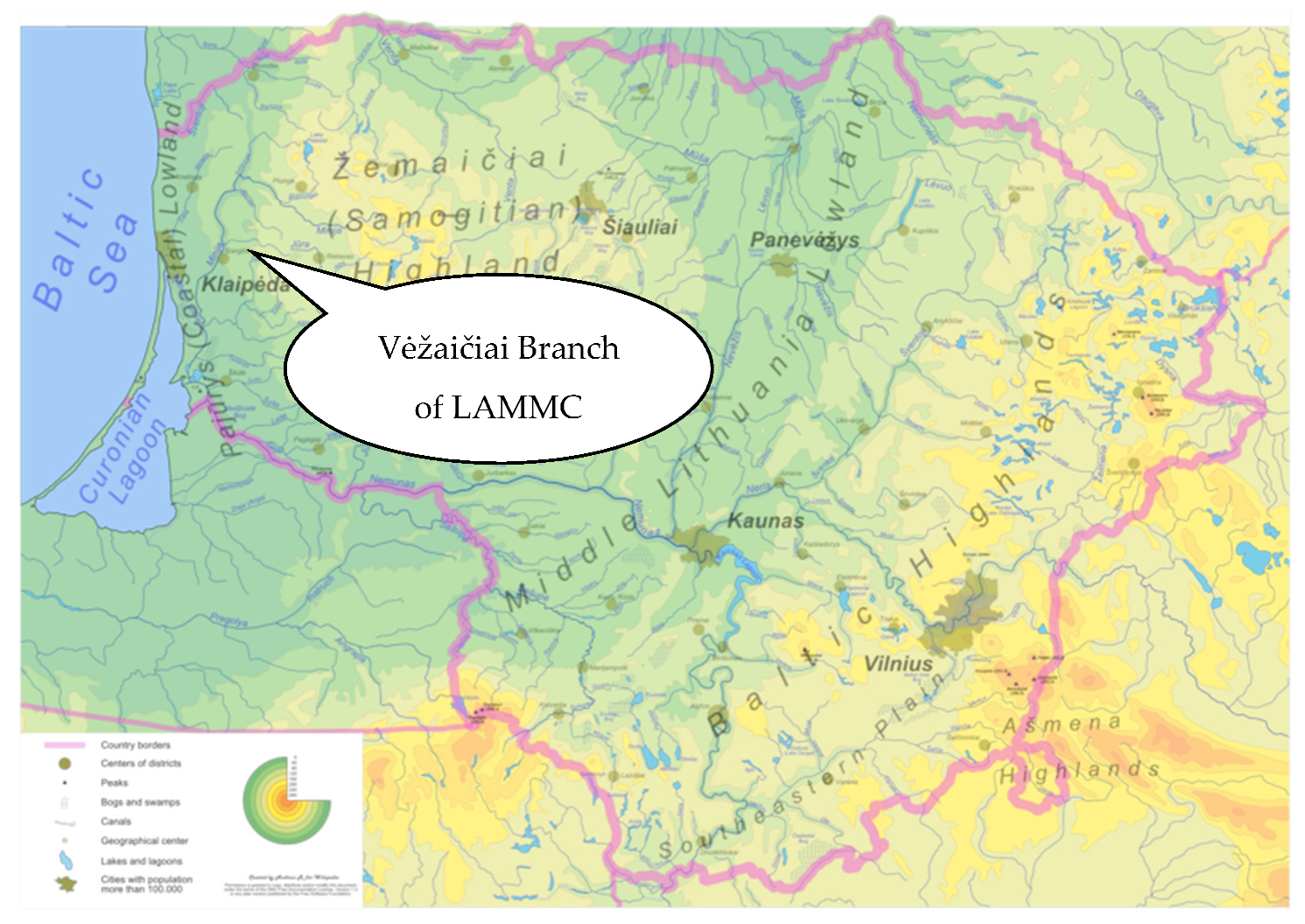

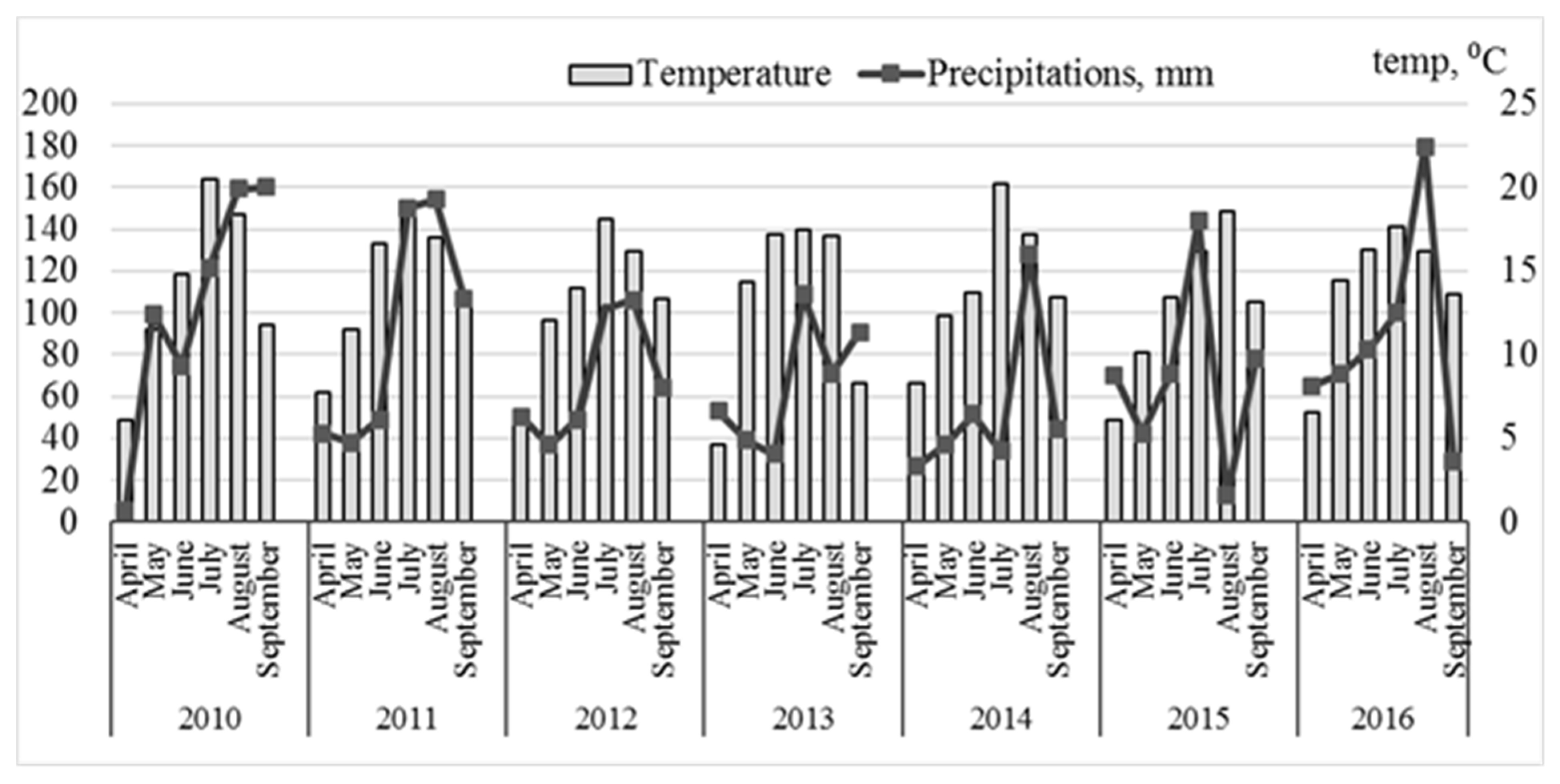
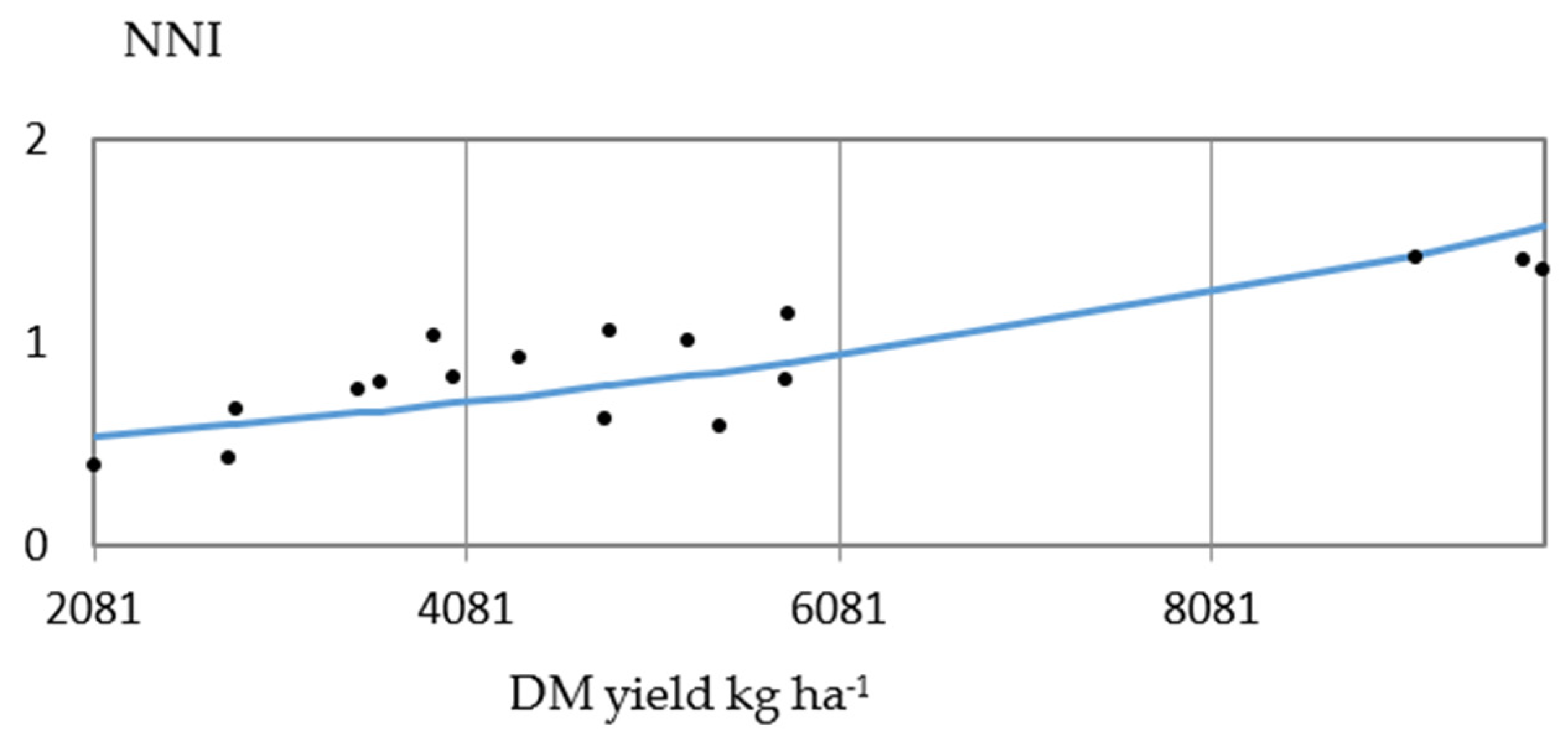
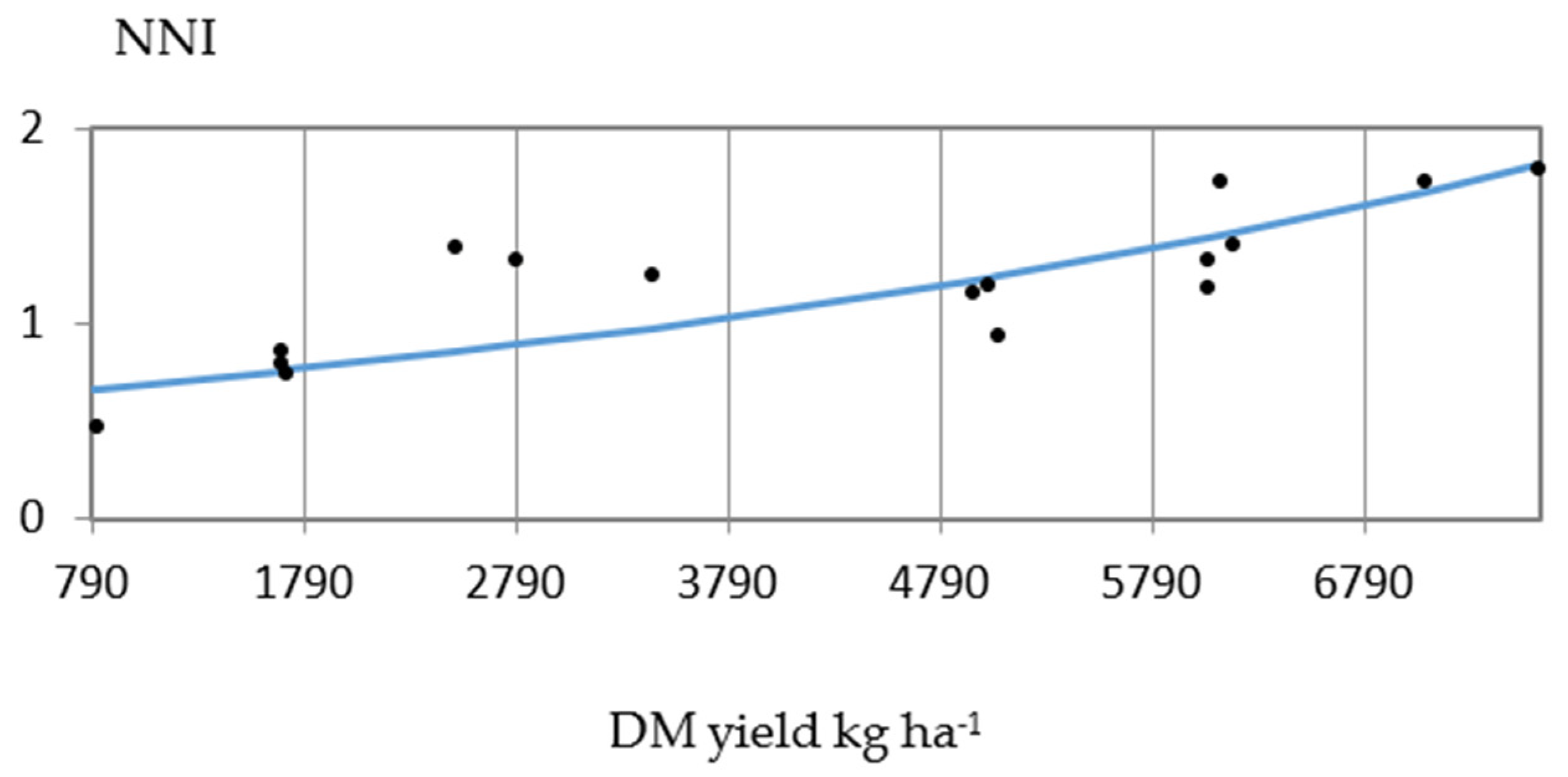
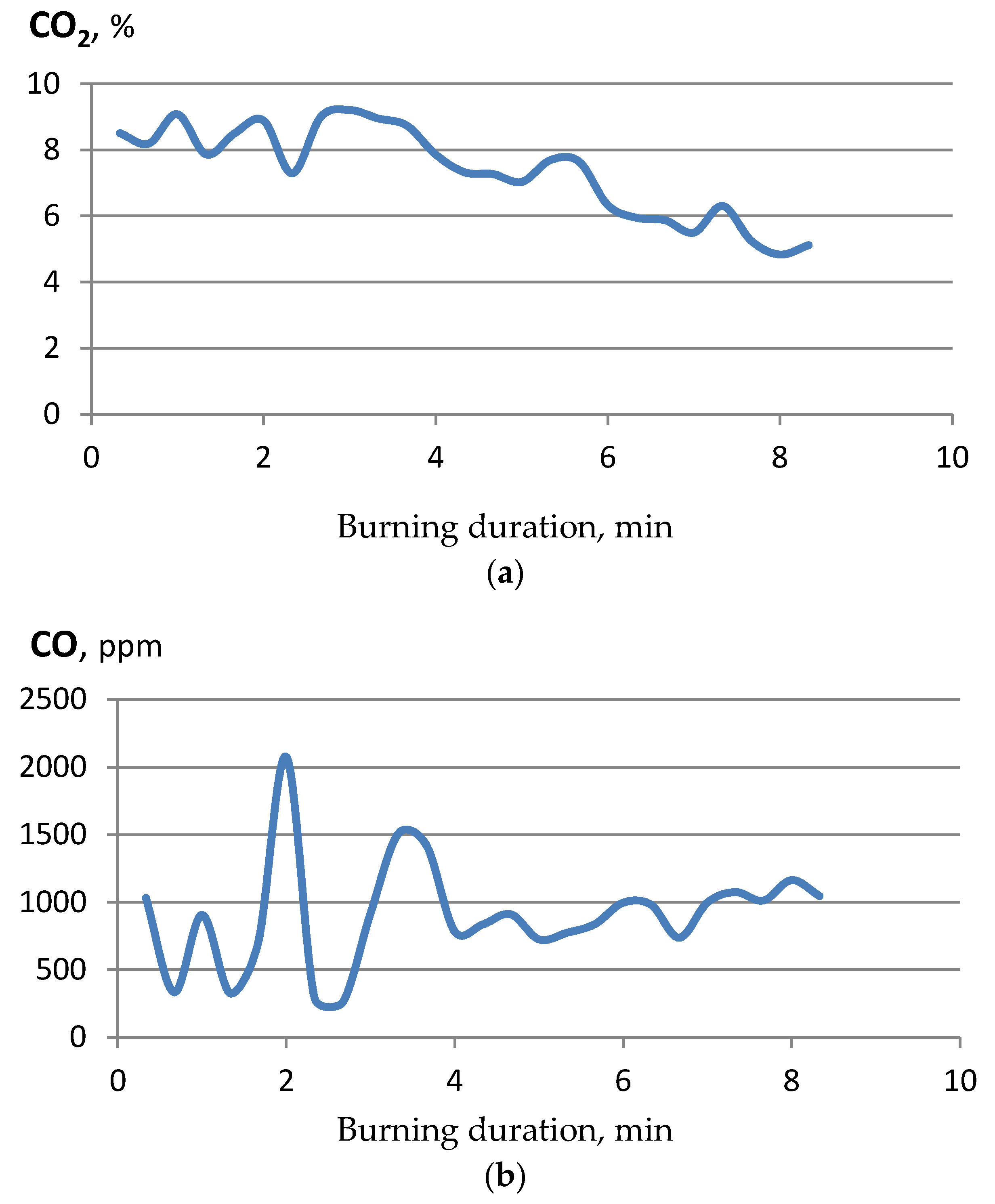
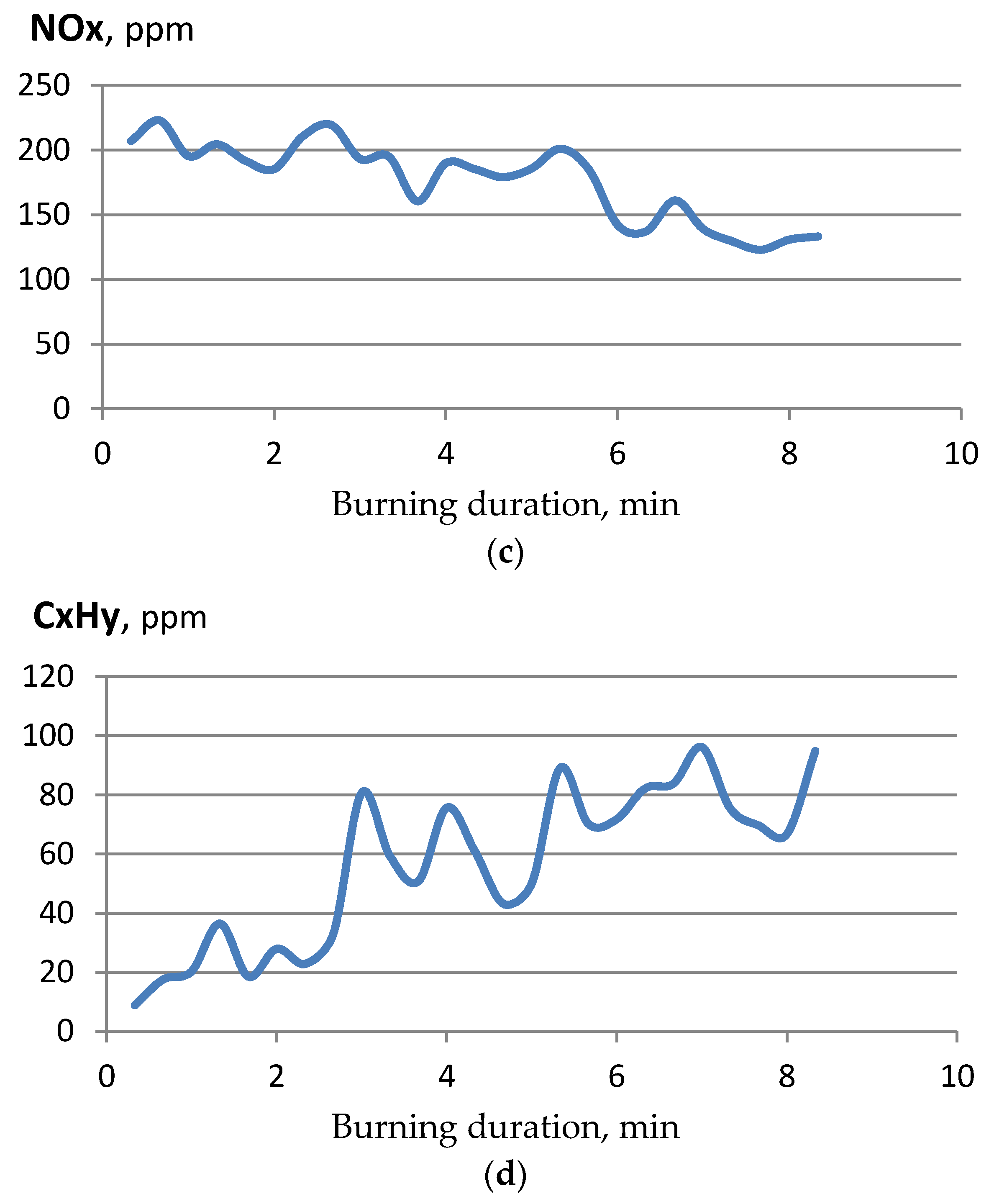
| Variables | DM (kg ha−1) | NUE | LUE | ||
|---|---|---|---|---|---|
| 1st cut | 2nd cut | Total | |||
| Y | ** | ** | ** | ** | ns |
| L | * | ns | ns | ns | ns |
| N | ** | ** | ** | ** | ns |
| Y × L | ns | ns | ns | ns | ns |
| Y × N | ** | ** | ** | ** | ns |
| L × N | ns | ns | ns | ns | ns |
| Y × L × N | ns | ns | ns | ns | ns |
| Variables | Dry Matter Yield (DM) (kg ha−1) | NUE (kg kg−1) | LUE (t kg−1) | ||
|---|---|---|---|---|---|
| 1st Cut Yield | 2nd Cut Yield | Total | |||
| Cultivation Year | |||||
| 2010 | 4116 | 4330 | 8445 | 38.24 | −54.16 |
| 2011 | 7432 | 3401 | 11,115 | 59.64 | 181.75 |
| 2012 | 4095 | 2410 | 6505 | 54.39 | −16.02 |
| 2013 | 4006 | 1696 | 5777 | 55.69 | −79.81 |
| 2014 | 3737 | 1731 | 5468 | 34.25 | 92.87 |
| 2015 | 5040 | 738 | 5443 | 40.49 | 177.31 |
| 2016 | 5198 | 2619 | 7535 | 40.88 | 254.81 |
| On average | 4803 | 2418 | 7184 | 46.22 | 79.53 |
| LSD05/01 | 325/431 | 226/299 | 465/644 | 8.39/11.1 | 205/272 |
| Liming CaCO3 (t ha−1) | |||||
| Not limed | 4547 | 2332 | 6434 | 43.41 | |
| 3.0 t ha−1 | 4936 | 2341 | 6604 | 42.73 | −6.16 |
| 6.0 t ha−1 | 4928 | 2379 | 6897 | 43.68 | 77.17 |
| LSD05/01 | 188/249 | 130/173 | 232/372 | 3.97/6.42 | 83.9/111 |
| Nitrogen application (kg ha−1) | |||||
| 0 kg ha−1 | 2932 | 1315 | 4015 | 77.16 | |
| 60 kg ha−1 | 4794 | 1523 | 6054 | 34.77 | −14.29 |
| 120 kg ha−1 | 6684 | 4415 | 9866 | 51.78 | 43.65 |
| LSD05/01 | 188/249 | 130/173 | 232/372 | 2.81/4.54 | 118.7/157 |
| Variables | Corg | Ntot | C:N Ratio | Cfib | Cfat | Cash | CV | NNI |
|---|---|---|---|---|---|---|---|---|
| 1st cut (full maturity stage) | ||||||||
| 2010 | 45.27 | 1.11 | 41.62 | 37.11 | 0.83 | 5.92 | 17.89 | 0.92 |
| 2011 | 45.76 | 1.12 | 41.84 | 38.78 | 0.85 | 5.08 | 18.00 | 1.15 ** |
| 2012 | 56.93 ** | 0.67 ** | 87.32 ** | 38.79 | 1.42 | 4.59 | 18.05 | 0.53 ** |
| LSD05/ 01 | 0.69/ 0.93 | 0.06/ 0.07 | 3.25/ 4.36 | 0.87/ 1.17 | 0.13/ 0.18 | 0.16/ 0.22 | 0.03/ 0.04 | 0.05/ 0.07 |
| Liming t ha−1 | ||||||||
| Not limed | 49.13 | 0.99 | 54.56 | 37.91 | 1.14 | 5.23 | 18.00 | 0.85 |
| 3.0 t ha−1 | 49.57 | 0.95 | 57.59 | 37.93 | 0.96 * | 5.23 | 17.94 * | 0.87 |
| 6.0 t ha−1 | 49.26 | 0.96 | 58.63 * | 38.85 | 1.01 | 5.14 | 17.99 | 0.88 |
| LSD05/ 01 | 0.69/ 0.93 | 0.05/ 0.07 | 3.25/ 4.36 | 0.87/ 1.17 | 0.13/ 0.18 | 0.16/ 0.22 | 0.03/ 0.04 | 0.05/ 0.07 |
| Nitrogen application, kg ha−1 | ||||||||
| 0 kg ha−1 | 49.26 | 0.90 | 60.90 | 37.41 | 1.07 | 5.43 | 17.91 | 0.69 |
| 120 kg ha−1 | 49.39 | 1.03 ** | 52.95 ** | 39.05 ** | 1.00 | 4.96 ** | 18.02 ** | 1.05 ** |
| LSD05/ 01 | 0.49/ 0.66 | 0.04/ 0.05 | 2.30/ 3.08 | 0.62/ 0.83 | 0.10/ 0.13 | 0.12/ 0.16 | 0.02/ 0.03 | 0.04/ 0.05 |
| 2nd cut (aftermath) | ||||||||
| 2010 | 44.98 | 1.78 | 25.88 | 30.49 | 1.78 | 8.12 | 17.51 | 1.53 |
| 2011 | 44.7 | 1.37 ** | 32.87 | 35.34 | 0.59 ** | 7.72 ** | 17.53 | 1.05 ** |
| 2012 | 56.26 ** | 1.27 ** | 48.11 ** | 30.26 ** | 0.92 ** | 6.38 ** | 17.59 | 0.81 ** |
| LSD05/ 01 | 0.52/ 0.69 | 0.11/ 0.15 | 3.25/ 4.37 | 0.58/ 0.78 | 0.13/ 0.18 | 0.24/ 0.32 | 0.06/ 0.08 | 0.12/ 0.16 |
| Liming t ha−1 | ||||||||
| Not limed | 48.29 | 1.44 | 33.78 | 31.78 | 1.18 | 7.51 | 17.50 | 1.14 |
| 3.0 t ha−1 | 48.66 | 1.47 | 36.38 | 32.07 | 1.15 | 7.35 | 17.50 | 1.11 |
| 6.0 t ha−1 | 48.79 | 1.52 * | 36.70 | 32.23 | 0.97* | 7.35 | 17.53 | 1.14 |
| LSD05/ 01 | 0.52/ 0.69 | 0.11/ 0.15 | 3.25/ 4.37 | 0.58/ 0.78 | 0.13/ 0.18 | 0.24/ 0.32 | 0.06/ 0.08 | 0.12/ 0.16 |
| Nitrogen application, kg ha−1 | ||||||||
| 0 kg ha−1 | 48.12 | 1.40 | 37.35 | 31.37 | 1.32 | 8.45 | 17.38 | 0.88 |
| 120 kg ha−1 | 49.17 ** | 1.55 ** | 33.89 ** | 32.69 ** | 0.88 ** | 6.36 ** | 17.64 ** | 1.38 ** |
| LSD05/ 01 | 0.36/ 0.49 | 0.10/ 0.13 | 2.30/ 3.09 | 0.41/ 0.56 | 0.09/ 0.13 | 0.17/ 0.22 | 0.04/ 0.06 | 0.08/ 0.11 |
| Plant Species | Parameters of Pellets | |||||
|---|---|---|---|---|---|---|
| Moisture content, % | Length, mm | Diameter, mm | Mass, g | Volume, m3 | Density, kg m−3 | |
| Reed canary grass | 6.7 | 23.62 ± 0.92 | 6.11 ± 0.10 | 0.85 ± 0.05 | 7.36 ± 0.42 × 10−7 | 1154.8 ± 94.5 1077.4 ± 88.1 (DM) |
| Wood sawdust | 7.6 | 30.61 ± 2.51 | 6.09 ± 0.12 | 1.06 ± 0.06 | 8.90 ± 0.59 × 10−7 | 1194.2 ± 50.0 1103.4 ± 46.2 (DM) |
| Plant Species | CO2 % | CO ppm | NOx ppm | CxHy ppm |
|---|---|---|---|---|
| Reed canary grass | 7.4 | 905.2 | 176.2 | 56.2 |
| Wood sawdust | 5.2 | 92.0 | 51.1 | 12.0 |
Publisher’s Note: MDPI stays neutral with regard to jurisdictional claims in published maps and institutional affiliations. |
© 2021 by the authors. Licensee MDPI, Basel, Switzerland. This article is an open access article distributed under the terms and conditions of the Creative Commons Attribution (CC BY) license (https://creativecommons.org/licenses/by/4.0/).
Share and Cite
Šiaudinis, G.; Jasinskas, A.; Šarauskis, E.; Skuodienė, R.; Repšienė, R.; Karčauskienė, D. The Influence of Lime Material and Nitrogen Fertilization on Reed Canary Grass Productivity, Plant Quality and Environmental Impact of Using Biomass for Energy Purposes. Agronomy 2021, 11, 895. https://doi.org/10.3390/agronomy11050895
Šiaudinis G, Jasinskas A, Šarauskis E, Skuodienė R, Repšienė R, Karčauskienė D. The Influence of Lime Material and Nitrogen Fertilization on Reed Canary Grass Productivity, Plant Quality and Environmental Impact of Using Biomass for Energy Purposes. Agronomy. 2021; 11(5):895. https://doi.org/10.3390/agronomy11050895
Chicago/Turabian StyleŠiaudinis, Gintaras, Algirdas Jasinskas, Egidijus Šarauskis, Regina Skuodienė, Regina Repšienė, and Danutė Karčauskienė. 2021. "The Influence of Lime Material and Nitrogen Fertilization on Reed Canary Grass Productivity, Plant Quality and Environmental Impact of Using Biomass for Energy Purposes" Agronomy 11, no. 5: 895. https://doi.org/10.3390/agronomy11050895
APA StyleŠiaudinis, G., Jasinskas, A., Šarauskis, E., Skuodienė, R., Repšienė, R., & Karčauskienė, D. (2021). The Influence of Lime Material and Nitrogen Fertilization on Reed Canary Grass Productivity, Plant Quality and Environmental Impact of Using Biomass for Energy Purposes. Agronomy, 11(5), 895. https://doi.org/10.3390/agronomy11050895







